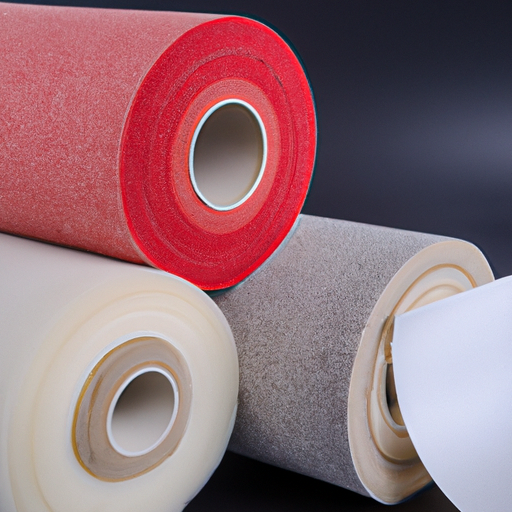while polyurethane coated woven fabric non-woven wool felt rolls are produced by Chinese factories,
Exploring the Benefits of Polyurethane Coated Woven Fabric Non-Woven Wool Felt Rolls from Chinese Factories
Polyurethane coated woven fabric non-woven wool felt rolls from Chinese factories offer a variety of benefits for a range of applications. These rolls are made from a combination of polyurethane and wool felt, which provides a unique combination of strength and flexibility. The polyurethane coating provides a protective layer that helps to protect the felt from wear and tear, while the wool felt provides a soft, comfortable feel.
The polyurethane coating also helps to reduce the amount of static electricity that is generated when the fabric is in contact with other materials. This can be beneficial in applications where static electricity can cause problems, such as in electronics or medical equipment. The coating also helps to reduce the amount of dust and dirt that can accumulate on the fabric, making it easier to clean and maintain.
The wool felt rolls from Chinese factories are also highly durable and can withstand a wide range of temperatures. This makes them ideal for use in a variety of environments, including outdoor applications. The felt is also resistant to water, making it suitable for use in wet areas.
The rolls are also available in a variety of colors and patterns, allowing for a wide range of design options. This makes them ideal for use in a variety of applications, including upholstery, curtains, and other decorative items. The rolls are also available in a variety of sizes, making them suitable for use in a variety of projects.
Overall, polyurethane coated woven fabric non-woven wool felt rolls from Chinese factories offer a variety of benefits for a range of applications. The protective coating helps to reduce static electricity and dust accumulation, while the wool felt provides a soft, comfortable feel. The rolls are also highly durable and can withstand a wide range of temperatures, making them suitable for use in a variety of environments. Finally, the rolls are available in a variety of colors and patterns, allowing for a wide range of design options.
How Polyurethane Coated Woven Fabric Non-Woven Wool Felt Rolls are Used in Different Industries
Polyurethane coated woven fabric non-woven wool felt rolls are used in a variety of industries for a variety of purposes. These rolls are made from a combination of polyurethane and wool felt, which makes them highly durable and resistant to wear and tear. The polyurethane coating provides a waterproof barrier, making them ideal for use in wet or damp environments.
The automotive industry is one of the most common users of polyurethane coated woven fabric non-woven wool felt rolls. These rolls are used to line the interior of vehicles, providing a comfortable and durable surface for passengers. The rolls are also used to line the exterior of vehicles, providing a protective barrier against the elements.
The construction industry is another major user of polyurethane coated woven fabric non-woven wool felt rolls. These rolls are used to line the walls and floors of buildings, providing insulation and soundproofing. The rolls are also used to line the roofs of buildings, providing a waterproof barrier against the elements.
The medical industry is another major user of polyurethane coated woven fabric non-woven wool felt rolls. These rolls are used to line medical equipment, providing a comfortable and durable surface for patients. The rolls are also used to line medical beds, providing a waterproof barrier against the elements.
The textile industry is another major user of polyurethane coated woven fabric non-woven wool felt rolls. These rolls are used to line clothing, providing a comfortable and durable surface for the wearer. The rolls are also used to line furniture, providing a waterproof barrier against the elements.
Polyurethane coated woven fabric non-woven wool felt rolls are used in a variety of industries for a variety of purposes. These rolls are highly durable and resistant to wear and tear, making them ideal for use in wet or damp environments. The polyurethane coating provides a waterproof barrier, making them ideal for use in a variety of industries.
Comparing the Quality of Polyurethane Coated Woven Fabric Non-Woven Wool Felt Rolls from Chinese Factories to Other Sources
When it comes to the quality of polyurethane coated woven fabric non-woven wool felt rolls, Chinese factories are often compared to other sources. It is important to understand the differences between these sources in order to make an informed decision when purchasing these products.
Chinese factories are known for producing high-quality polyurethane coated woven fabric non-woven wool felt rolls. These products are often made with superior materials and craftsmanship, resulting in a product that is durable and long-lasting. Additionally, Chinese factories often offer competitive prices, making them a great option for those looking for a cost-effective solution.
However, there are some drawbacks to purchasing polyurethane coated woven fabric non-woven wool felt rolls from Chinese factories. For one, the quality control standards may not be as stringent as those of other sources. Additionally, the lead times for delivery may be longer than those of other sources.
When comparing the quality of polyurethane coated woven fabric non-woven wool felt rolls from Chinese factories to other sources, it is important to consider the pros and cons of each. Other sources may offer higher quality control standards and shorter lead times, but they may also be more expensive. Ultimately, the decision should be based on the individual needs and budget of the buyer.
In conclusion, when comparing the quality of polyurethane coated woven fabric non-woven wool felt rolls from Chinese factories to other sources, it is important to consider the pros and cons of each. Chinese factories offer competitive prices and high-quality products, but other sources may offer higher quality control standards and shorter lead times. Ultimately, the decision should be based on the individual needs and budget of the buyer.
